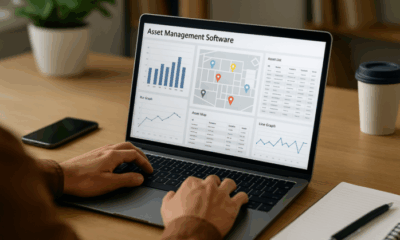Entrepreneurs
The Day I Stopped Selling and Built a Business

The advertising agency I’d joined was the most competitive and ambitious in London. Building business was hardwired into every one of us. Competition with other internal teams was part of the process. Jumping to the top of the queue above other teams for the next new business prospect gave us more opportunities for winning new business. We were trained to present, to sell, and sell again and again. And I was desperate to succeed.
Failure could be challenging. Our creative teams could be fearsome to deal with. Emotions ran high — sometimes way too high, with unpleasant consequences.I planned to stay for a year or so. But twelve years passed quickly, and I ended up running a big group. The rewards for those of us who succeeded were good, but I wanted more.
I took a big, big risk and started a breakaway agency with seven colleagues. With a full team and a great office in the center of London, we had a stupidly large overhead from Day One. We also had no client and no income. We had to sell to survive. Every single opportunity, every new business prospect, however small, was critical. Our family houses, the school fees, the grocery bills and everything we owned depended on winning business.
We were good — mostly, very good. Even if we lost a new business pitch, we didn’t give up. Sure, this irritated some prospects, but mostly they appreciated our hunger.
Every idea had to be sold and nurtured. Every opportunity, however small, exploited. Our lives and our families depended on it. And at the end of the first year, we broke even. Our bankers were so amazed they threw us a private lunch to celebrate.
Then times got edgy. We had big debts. We restructured, redoubled our efforts and focused harder on winning business. We survived — and produced some outstanding work.
After years and years of selling the agency to prospects, to staff, stakeholders and selling work to clients, I realized something. I was dog tired. I was exhausted from filling the leaky bucket of revenue over and over again. I knew it was time to merge my agency and get out. I stopped selling.
New Business. No Selling
After a stint at business school, I was back in business, but this time, on my own. I had no website and no name plate on my office. I was invisible, and I didn’t sell. I just told past clients and colleagues what I was planning and doing.
For four months, the phone was quiet. Then it rang. I met with the prospect — and instead of selling and telling him about my offer, I just asked questions about his company and what problems required attention. I checked the size, importance and cost of those problems.
He was interested in working with me, and I was interested in working with him. I wrote a two-paragraph summary of how to tackle the issues and added a price range. It was large and provided good value.
And the phone continued to ring, despite no website, no marketing, no sales activity, and no long submissions. I refused to write submissions – only one-page outlines. I just asked questions.
“Telling is not selling. Only asking questions is selling.” – Brian Tracy
Really. No Selling.
A few years later I co founded The Client Relationship Consultancy. Again: no website, no marketing, no selling. I met with past colleagues and explained our philosophy. We made them sign a two-way NDA — we would never talk about them, and they would never talk about us.
But they wanted to work with us. As clients moved to new agencies, the word spread and we got more calls. These new prospects wanted credentials presentations. I explained that I would tell them about our business for less than sixty seconds, and about our philosophy and approach for four minutes. At that point, if they did not agree with our approach, we could cut short the meeting and I might be able to suggest others who could be a better fit for them. But no one ever said that. And we still had a two-way NDA.
We never chased after a meeting. If I thought a prospect would not be right for us, I would decline their business. Occasionally, existing clients wanted to do things differently. If whatever they suggested failed to meet our philosophy, we refused to work with them.
I loved this new way of carrying out business. I felt re energized. And our clients stuck.
To my business partners’ intense irritation, I refused to set annual targets. I did not want to feel that I needed to sell. But over sixteen years, our business grew and grew — to offices and consultants in London, Windsor, Boston, Mexico, Munich, Singapore and Sydney. Still no website. Still no new business or marketing activity. Still a two-way NDA.
Why It Worked
Why did this approach work? Not having objectives for sales, and not selling, meant that I had a powerful position, equal to that of a prospective client. I could relax. As a result, so could the client. We were able to have adult to adult conversations. The prospective clients became less defensive, and more open to me. They were comfortable disclosing deeper, underlying issues.
Both parties had the opportunity to ensure that the ‘fit’ between was tight. Both sides had the chance to ensure that our beliefs were in synch. The result: long-term, enduring relationships, and no leaky buckets anywhere.
Change Your Mindset
The Silent Skill That Makes People Respect You Instantly
What truly earns respect and why most people go about it the wrong way

Everybody craves respect but not everyone earns it. Some people believe that a title, years of experience, or a position of authority automatically entitles them to respect. (more…)
Entrepreneurs
The Essential Skills Every Entrepreneur Needs In 2026
Success in the digital age isn’t about luck. It’s about mastering the skills that separate dreamers from doers.

When I was 22 years old, I started my first side hustle as a ghostwriter. (more…)
Business
The Hidden Money Pit in Your Operations (and How to Use It)
See how smart asset management software is quietly saving businesses thousands in wasted time, stock, and maintenance.

Trimming unnecessary expenses and minimizing resources is a general practice in running a business effectively. Asset management software can help you achieve those goals. (more…)
Business
Thinking of Buying A Business? These 6 Sectors Quietly Produce the Best Deals
Before you buy your next venture, check out the sectors where successful businesses are changing hands every day.

All entrepreneurs have a desire to be the masters behind a successful venture. Buying an established business is a great choice for many. This provides instant access to an established market with existing infrastructure and clients. (more…)
-

 Shift Your Mindset4 weeks ago
Shift Your Mindset4 weeks ago11 E’s That Define Every Great Leader And Why Most People Miss Them
-

 Did You Know3 weeks ago
Did You Know3 weeks agoThe Success Patterns You Inherited (And Didn’t Notice)
-

 Entrepreneurs3 weeks ago
Entrepreneurs3 weeks agoThe Essential Skills Every Entrepreneur Needs In 2026
-

 Business3 weeks ago
Business3 weeks agoThe Hidden Money Pit in Your Operations (and How to Use It)
-

 Change Your Mindset2 weeks ago
Change Your Mindset2 weeks agoHow to Turn Your Mind Into Your Greatest Asset (Instead of Your Enemy)
-

 Change Your Mindset2 weeks ago
Change Your Mindset2 weeks agoThe Silent Skill That Makes People Respect You Instantly
-

 Life1 week ago
Life1 week ago10 Research-Backed Steps to Create Real Change This New Year
-

 Tech1 week ago
Tech1 week agoWhat’s in a Name? How to Get Your Domain Right

























